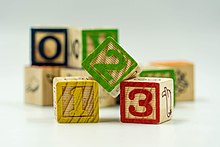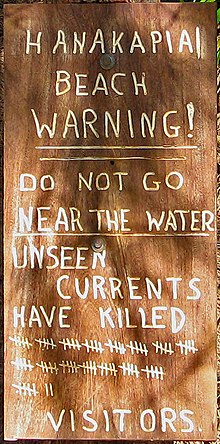Counting

Countingis the process of determining thenumberofelementsof afinite setof objects; that is, determining thesizeof a set. The traditional way of counting consists of continually increasing a (mental or spoken) counter by aunitfor every element of the set, in some order, while marking (or displacing) those elements to avoid visiting the same element more than once, until no unmarked elements are left; if the counter was set to one after the first object, the value after visiting the final object gives the desired number of elements. The related termenumerationrefers to uniquely identifying the elements of afinite(combinatorial)setor infinite set by assigning a number to each element.
Counting sometimes involves numbers other than one; for example, when counting money, counting out change, "counting by twos" (2, 4, 6, 8, 10, 12,...), or "counting by fives" (5, 10, 15, 20, 25,...).
There is archaeological evidence suggesting that humans have been counting for at least 50,000 years.[1]Counting was primarily used by ancient cultures to keep track of social and economic data such as the number of group members, prey animals, property, or debts (that is,accountancy). Notched bones were also found in the Border Caves in South Africa, which may suggest that the concept of counting was known to humans as far back as 44,000 BCE.[2]The development of counting led to the development ofmathematical notation,numeral systems,andwriting.
Forms of counting
[edit]
Verbal counting involves speaking sequential numbers aloud or mentally to track progress. Generally such counting is done withbase 10numbers: "1, 2, 3, 4", etc. Verbal counting is often used for objects that are currently present rather than for counting things over time, since following an interruption counting must resume from where it was left off, a number that has to be recorded or remembered.
Counting a small set of objects, especially over time, can be accomplished efficiently withtally marks:making a mark for each number and then counting all of the marks when done tallying. Tallying isbase 1counting.
Finger countingis convenient and common for small numbers. Children count on fingers to facilitate tallying and for performing simple mathematical operations. Older finger counting methods used the four fingers and the three bones in each finger (phalanges) to count to twelve.[3]Other hand-gesture systems are also in use, for example the Chinese system by which one can count to 10 using only gestures of one hand. Withfinger binaryit is possible to keep a finger count up to1023 = 210− 1.
Various devices can also be used to facilitate counting, such astally countersandabacuses.
Inclusive counting
[edit]Inclusive/exclusive counting are terms used for counting intervals. For inclusive counting the starting point is one; for exclusive counting the starting point is zero. Inclusive counting is usually encountered when dealing with time inRoman calendarsand theRomance languages.[4]In theancient Roman calendar,thenones(meaning "nine" ) is 8 days before theides;more generally, dates are specified as inclusively counted days up to the next named day.[4]In theChristian liturgical calendar,Quinquagesima(meaning 50) is 49 days before Easter Sunday. When counting "inclusively", the Sunday (the start day) will beday 1and therefore the following Sunday will be theeighth day.For example, the French phrase for "fortnight"isquinzaine(15 [days]), and similar words are present in Greek (δεκαπενθήμερο,dekapenthímero), Spanish (quincena) and Portuguese (quinzena). In contrast, the English word "fortnight" itself derives from "a fourteen-night", as the archaic "sennight"does from" a seven-night "; the English words are not examples of inclusive counting. In exclusive counting languages such as English, when counting eight days" from Sunday ", Monday will beday 1,Tuesdayday 2,and the following Monday will be theeighth day.[citation needed]For many years it wasa standard practice in English lawfor the phrase "from a date" to mean "beginning on the day after that date": this practice is now deprecated because of the high risk of misunderstanding.[5]
Similar counting is involved inEast Asian age reckoning,in whichnewbornsare considered to be 1 at birth.
Musical terminology also uses inclusive counting ofintervalsbetween notes of the standard scale: going up one note is a second interval, going up two notes is a third interval, etc., and going up seven notes is anoctave.
Education and development
[edit]Learning to count is an important educational/developmental milestone in most cultures of the world. Learning to count is a child's very first step into mathematics, and constitutes the most fundamental idea of that discipline. However, some cultures in Amazonia and the Australian Outback do not count,[6][7]and their languages do not have number words.
Many children at just 2 years of age have some skill in reciting the count list (that is, saying "one, two, three,..." ). They can also answer questions of ordinality for small numbers, for example, "What comes afterthree?".They can even be skilled at pointing to each object in a set and reciting the words one after another. This leads many parents and educators to the conclusion that the child knows how to use counting to determine the size of a set.[8]Research suggests that it takes about a year after learning these skills for a child to understand what they mean and why the procedures are performed.[9][10]In the meantime, children learn how to name cardinalities that they cansubitize.
Counting in mathematics
[edit]In mathematics, the essence of counting a set and finding a resultn,is that it establishes aone-to-one correspondence(or bijection) of the subject set with the subset of positive integers {1, 2,...,n}. A fundamental fact, which can be proved bymathematical induction,is that no bijection can exist between {1, 2,...,n} and {1, 2,...,m} unlessn=m;this fact (together with the fact that two bijections can becomposedto give another bijection) ensures that counting the same set in different ways can never result in different numbers (unless an error is made). This is the fundamental mathematical theorem that gives counting its purpose; however you count a (finite) set, the answer is the same. In a broader context, the theorem is an example of a theorem in the mathematical field of (finite)combinatorics—hence (finite) combinatorics is sometimes referred to as "the mathematics of counting."
Many sets that arise in mathematics do not allow a bijection to be established with {1, 2,...,n} foranynatural numbern;these are calledinfinite sets,while those sets for which such a bijection does exist (for somen) are calledfinite sets.Infinite sets cannot be counted in the usual sense; for one thing, the mathematical theorems which underlie this usual sense for finite sets are false for infinite sets. Furthermore, different definitions of the concepts in terms of which these theorems are stated, while equivalent for finite sets, are inequivalent in the context of infinite sets.
The notion of counting may be extended to them in the sense of establishing (the existence of) a bijection with some well-understood set. For instance, if a set can be brought into bijection with the set of all natural numbers, then it is called "countably infinite."This kind of counting differs in a fundamental way from counting of finite sets, in that adding new elements to a set does not necessarily increase its size, because the possibility of a bijection with the original set is not excluded. For instance, the set of allintegers(including negative numbers) can be brought into bijection with the set of natural numbers, and even seemingly much larger sets like that of all finite sequences of rational numbers are still (only) countably infinite. Nevertheless, there are sets, such as the set ofreal numbers,that can be shown to be "too large" to admit a bijection with the natural numbers, and these sets are called "uncountable."Sets for which there exists a bijection between them are said to have the samecardinality,and in the most general sense counting a set can be taken to mean determining its cardinality. Beyond the cardinalities given by each of the natural numbers, there is an infinite hierarchy of infinite cardinalities, although only very few such cardinalities occur in ordinary mathematics (that is, outsideset theorythat explicitly studies possible cardinalities).
Counting, mostly of finite sets, has various applications in mathematics. One important principle is that if two setsXandYhave the same finite number of elements, and a functionf:X→Yis known to beinjective,then it is alsosurjective,and vice versa. A related fact is known as thepigeonhole principle,which states that if two setsXandYhave finite numbers of elementsnandmwithn>m,then any mapf:X→Yisnotinjective (so there exist two distinct elements ofXthatfsends to the same element ofY); this follows from the former principle, since iffwere injective, then so would itsrestrictionto a strict subsetSofXwithmelements, which restriction would then be surjective, contradicting the fact that forxinXoutsideS,f(x) cannot be in the image of the restriction. Similar counting arguments can prove the existence of certain objects without explicitly providing an example. In the case of infinite sets this can even apply in situations where it is impossible to give an example.[citation needed]
The domain ofenumerative combinatoricsdeals with computing the number of elements of finite sets, without actually counting them; the latter usually being impossible because infinite families of finite sets are considered at once, such as the set ofpermutationsof {1, 2,...,n} for any natural numbern.
See also
[edit]- Calculation
- Card reading (bridge)
- Cardinal number
- Combinatorics
- Count data
- Counting (music)
- Counting problem (complexity)
- Developmental psychology
- Elementary arithmetic
- Finger counting
- History of mathematics
- Jeton
- Level of measurement
- List of numbers
- Mathematical quantity
- Ordinal number
- Particle number
- Subitizing and counting
- Tally mark
- Unary numeral system
- Yan tan tethera(Counting sheep in Britain)
References
[edit]- ^An Introduction to the History of Mathematics(6th Edition) byHoward Eves(1990) p.9
- ^"Early Human Counting Tools".Math Timeline.Retrieved2018-04-26.
- ^Macey, Samuel L. (1989).The Dynamics of Progress: Time, Method, and Measure.Atlanta, Georgia: University of Georgia Press. p. 92.ISBN978-0-8203-3796-8.
- ^abEvans, James (1998)."4".The History and Practice of Ancient Astronomy.Oxford University Press. p. 164.ISBN019987445X.
- ^"Drafting bills for Parliament".gov.uk.Office of the Parliamentary Counsel. 18 June 2020.See heading 8.
- ^Butterworth, B.,Reeve, R., Reynolds, F., & Lloyd, D. (2008). Numerical thought with and without words: Evidence from indigenous Australian children. Proceedings of the National Academy of Sciences, 105(35), 13179–13184.
- ^Gordon, P. (2004). Numerical cognition without words: Evidence from Amazonia. Science, 306, 496–499.
- ^Fuson, K.C. (1988). Children's counting and concepts of number. New York: Springer–Verlag.
- ^Le Corre, M., & Carey, S. (2007). One, two, three, four, nothing more: An investigation of the conceptual sources of the verbal counting principles. Cognition, 105, 395–438.
- ^Le Corre, M., Van de Walle, G., Brannon, E. M., Carey, S. (2006). Re-visiting the competence/performance debate in the acquisition of the counting principles. Cognitive Psychology, 52(2), 130–169.
